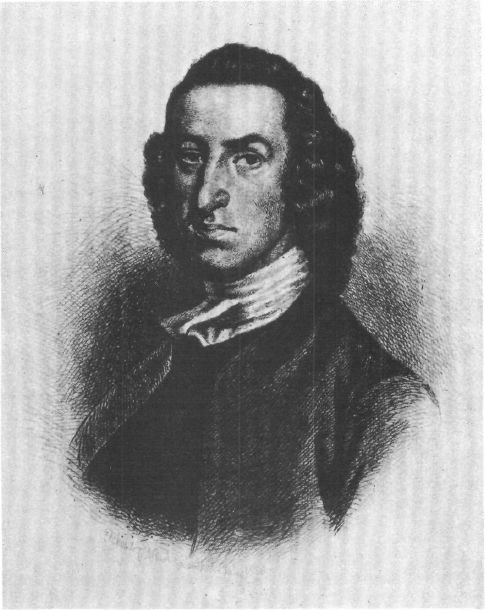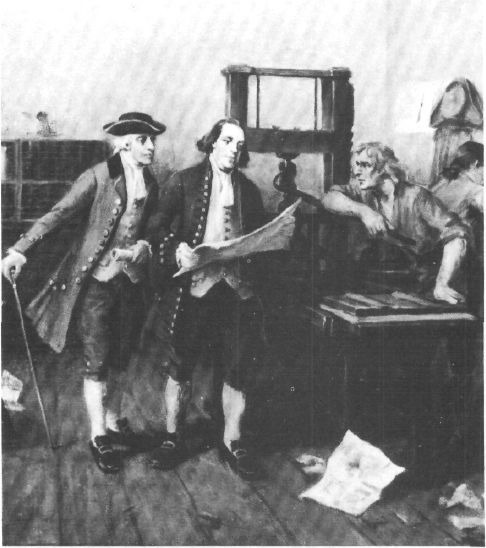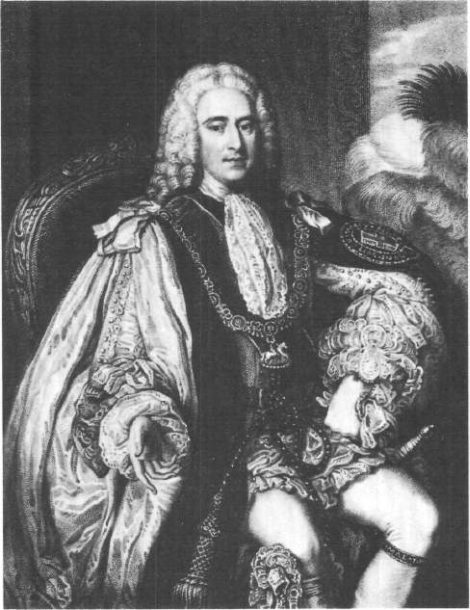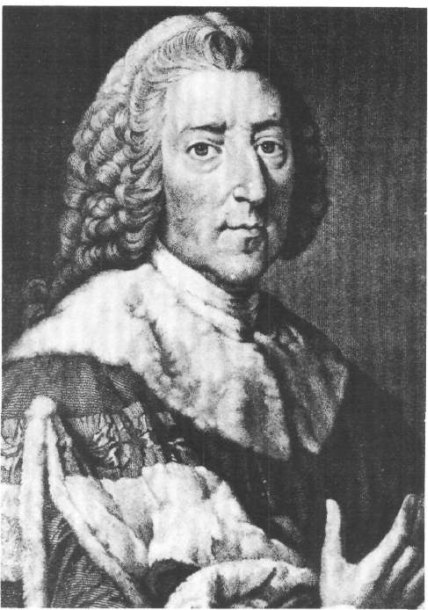Conceived in Liberty (116 page)
Read Conceived in Liberty Online
Authors: Murray N. Rothbard

The Metropolitan Museum of Art, Bequest of Charles Allen Munn, 1924
Governor Shirley of Massachusetts

Courtesy of The New-York Historical Society
William Livingston

Courtesy of The New-York Historical Society
General Oglethorpe

Courtesy of The New-York Historical Society
Benjamin Franklin in His Print Shop

New York Public Library
Thomas Pelham, Duke of Newcastle

Courtesy of The New-York Historical Society
William Pitt the Elder
*
Isabel Paterson, “The Humanitarian with the Guillotine,” in
The God of the Machine
(New York: G. P. Putnam Sons, 1943), p. 241. More fully, Paterson points out that “the humanitarian wishes to be a prime mover in the lives of others. He cannot admit either the divine or the natural order by which men have the power to keep themselves. The humanitarian puts himself in the place of God.
“But he is confronted by two awkward facts: first, that the competent do not need his assistance; and second, that the majority of people, if unperverted, positively do not want to be ‘done good’ by the humanitarians.... Shall A do what he thinks is good for B and B do what he thinks is good for A? Or shall A accept only what he thinks is good for B and vice versa? But that is absurd. Of course, what the humanitarian actually proposes is that
he
shall do what he thinks is good for everybody. It is at this point that the humanitarian sets up the guillotine”
(ibid.).
*
Albert B. Saye,
New Viewpoints in Georgia History
(Athens, Ga.: University of Georgia Press, 1943).
*
Daniel J. Boorstin,
The Americans: The Colonial Experience
(New York: Random House, 1958), p. 57.
*
The handful of Jews in the colonies, largely Sephardim and merchants, were concentrated in the cities of Newport, New York, Philadelphia, and Charleston.
Intercolonial Developments
26
Inflation and the Creation of Paper Money
So far we have been concentrating on the leading developments in
each colony
in the first half of the eighteenth century, in the “domestic” affairs, so to speak, peculiar to the colony. Now let us turn to the increasingly important experiences that were common to several or all of the colonies, experiences that helped to impart a greater degree of community in colonies that originated as completely separate and independent entities. Among these we can distinguish two categories: first, events and developments that, while still chiefly domestic to the colonies, permeated some or all of them (for example, such new developments as paper money or such intellectual currents as the Great Awakening); second, “foreign affairs”—that is, the emergence of common relations and problems outside the colonies, specifically relations with Great Britain and the British Empire, with the other European colonies in North America (France and Spain), and with the Indians (the last two spheres often blending). Many of the predominantly domestic questions, of course, had external ramifications, particularly
vis-à-vis
Great Britain.
Turning first to domestic developments shared by the various colonies in the first half of the eighteenth century, one of the most important was the creation of an entirely new and destructive economic device: paper money. Apart from isolated China, during the Middle Ages, money had always emerged on the market as a useful commodity: whether goods like tobacco and grain, as in the colonies, or the more widely used but more expensive gold and silver. In any case, the monetary commodity could only be produced as other goods were: by the use of labor and capital to transform material resources into more desirable forms—for example, by growing and picking tobacco or by mining gold. Again, as in the case of other goods, the monetary commodity could
then be acquired either by direct production, or by purchasing some other good or service and exchanging it for money.
National monetary units were not regarded as independent entities in any sense, but merely national names for units of weight of gold or silver. Hence, foreign coins of varying weights of gold and silver could and did easily circulate throughout the world, if unhampered by government regulations, since their value rested in their specie content rather than in their name. Until the seventeenth century, money
was
gold or silver or some other commodity, and there was no way to increase its stock except by purchasing more of the metal. The kings and princes, it is true, found a way to increase their share: by
debasement
—devaluating the specie content of the national coin and unit, and keeping the remainder, the “seigniorage,” for themselves.
Credit exchanges and merchant banking developed during the flowering of commercial capitalism of the medieval northern Italian cities. At first, these banking transactions promoted the advance of the market and of commercial capitalism without adding to or disturbing the supply of money. Eventually, however, some of the bankers began to accept deposits of money for safekeeping, and then began profiting on their depositors’ money by lending out the money or lending newly created deposit claims on the money deposits. In this way, new money, or rather new
evidences
of money, was pumped into the economy essentially out of thin air, and by means of virtual embezzlement of depositors’ funds.
Deposit banking did not loom large in the Italian or European economy, however, and failures by deposit bankers in Venice led to government banking based on true money-warehouse principles. In 1587, Venice established a deposit bank in which deposits were matched one hundred percent by money in the bank’s vaults; therefore, no fraudulent or inflationary increase of the money supply could take place. By 1619, however, the government’s need for funds and the temptation to cheat brought about a relaxation of the one-hundred-percent rule. Soon the one-hundred-percent principle was followed by new banks created in other cities, especially at Amsterdam in 1609 and at Hamburg ten years later.
In England, commercial banking began in the mid-seventeenth century with gold being deposited for safekeeping with London goldsmiths, who issued notes or book claims as evidences of gold deposited there. Since the depositors were the true owners of the gold, there were not supposed to be more such warehouse receipts than gold in the vaults. But eventually, the goldsmiths began to yield to the temptation of fraudulently increasing the money supply, through issue of pseudowarehouse receipts. Yet, before the late seventeenth century, there was no important amount of bank money or bank issues beyond gold or silver (and that generally ancillary to other financial business) and none at all in the American colonies. And there was no case at all concerning the issue of government paper money, let alone government
paper made a compulsory medium for payment of all debts (“legal tender”).
We have seen above that when money remains exclusively a commodity (or as simply warehouse receipts fully representing the money commodity in the warehouse), it must be obtained by production or by exchange of goods. But bank money or government money, whether as tangible notes or demand deposits, is an increase in the effective money supply virtually out of thin air. What are the economic consequences of such an increase?
The important point about the economics of money is that once a commodity is chosen as money by the market,
any
amount of its supply is optimal. In short, no social benefit is ever conferred by an increase in the supply of money in society. This contrast to other useful goods is due to the fact that
money
is used only for exchange of other goods; it does not, like other goods, perform its service by being used up in production or consumption. Money exchanges with all other goods on terms set by the market. These terms, established by the interplay of market supply and demand, constitute the array of money prices in society. If the supply of money in society should increase, the purchasing power of each unit of money relative to goods will fall (that is, prices will rise); if the supply of money should decline, then the purchasing power of each unit will rise (prices will fall). In short, an increase in the money supply only dilutes the effectiveness of each unit of money (for instance, the gold ounce); a fall in the supply raises the power of each unit to do its work. Whatever happens to the supply of money, prices will thus adjust themselves so as to carry on the work of exchange as efficiently as possible. No one size of the money stock, then, is better than any other.
An increase in the supply of gold or silver, therefore, confers no social benefit by increasing the supply of money; prices will rise and the public will be no better off than before. The addition, however, does confer a social benefit by increasing the
non
monetary uses of gold or silver. But the creation through book accounts or paper issues does not yield this indirect benefit;
this
creation is wholly parasitical.
If the creation of bank money or government paper is not socially useful, this does not mean that its economic consequences are trivial or unimportant. Quite the contrary. For the creation of paper money
severs
the vital market link between production and income; for now nonproducers are able, so to speak, to “counterfeit,” to create their own money and to use it to bid away resources from genuine producers. Money creation, in short, redistributes income and wealth from producers to legalized counterfeiters, and to the witting or unwitting beneficiaries of this counterfeiting. Second, this redistribution is effected by subtle and silent means, and this does not raise the opposition provoked by the more direct bludgeon of, say, taxation—and—government spending. Third, the
inflation
(issue of notes or deposits beyond the stock of specie) weakens and ultimately wrecks the integrity of the monetary unit. For the unit now must embrace pseudowarehouse receipts and fraudulent
“dollars” or “pounds” or “francs,” which do not at all represent actual weights of the money commodity. As a result, all the users of the money will be hurt and will find their money declined in value. In fact, the market will quickly tend to depreciate the paper money or banknotes in relation to genuine money, and this might happen even if government bolsters the use of money by force (for example, by declaring it legal tender).
